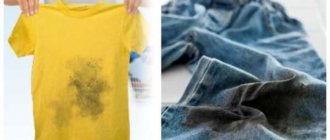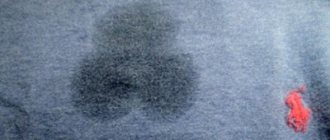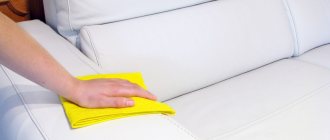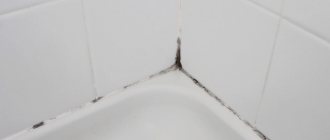As a rule, when working with silicone sealant, IZ products are used. But there are situations when, while observing safety measures, the substance still gets on the skin. It is more difficult to remove sealant from your hands than from clothes. There you can experiment and use strong substances, but you can’t do that with skin.
Review of popular removal methods from various surfaces
Once on the surface, the sealant hardens quickly and is difficult to remove using conventional means.
Mechanical
pry the material with a knife or other sharp object and pull carefully; Scrape off the silicone using a metal scraper or spatula by scraping. The main part of the contamination is removed with a sharp object, then the surface is cleaned with a layer of sandpaper; The mechanical method is well suited for floor coverings (laminate). The above methods are suitable for dark surfaces that are highly resistant, otherwise you can remove the stain along with paint and acrylic
The above methods are suitable for dark surfaces that have increased resistance; otherwise, you can remove the stain along with the paint and acrylic.
Chemical
When using chemicals on a thick layer of sealant, pre-treat the seams with a rag with a remover.
The chemical substance is selected depending on its composition. There are one- and two-component silicones. Acidic ones are removed with concentrated vinegar or a solvent, alcoholic ones are removed with ethyl alcohol, neutral ones are dissolved with white spirit.
There is another classification of silicones.
- plumbing – used for sealing sanitary facilities: acrylic bathtub, shower stall;
- adhesive-sealant – used in the manufacture of glass and glass-ceramic products: aquariums, stained glass windows;
- silicones with antifungal additives - used in aquariums and swimming pools.
| Chemical name | Peculiarities |
| White Spirit | Consists of aliphatic and aromatic hydrocarbons. Use on unpainted surfaces, otherwise the sealant will be removed along with the paint. |
| Penta-840 | Universal solvent, used under any storage conditions and air temperature. Apply the substance to the required surface, wait until completely softened, and rinse with plenty of water. |
| Antisil | Silicone degreaser. |
| Dow Corning OS-2 | A product for removing substances from PVC and acrylic surfaces. |
| Silicon-Entferner | Removes from enamel, metal, plastic surfaces. |
| Lugato Silber Shutz Silicon | In addition to removal, it prevents the appearance of fungus and mold. |
Household methods
fresh stains are removed with a cloth soaked in soapy water. You can clean the brush by soaking it in warm detergent; the method of removal depends on its composition. Neutral seals are made on the basis of alcohol, alkaline – on the basis of alkali, acid – using acetic acid. To remove, soak the sealant in the material on which it is based; consider the type of surface. It is forbidden to treat wooden kitchen surfaces (countertops) with acetone or white spirit, metal ones with vinegar (to prevent corrosion); to get rid of silicone on ceramics, first treat with a solvent, and after half an hour rub the stain; The easiest way is to wipe off old stains from plastic. It is enough to soak the surface, after half an hour treat it with a solvent, then with a degreasing solution
Use acetone with caution on plastic, as there is a risk of it softening; removed from metal mechanically (use a knife or scissors); It is easy to wipe off traces of silicone sealant from glass if you preheat it; If the sealant needs to be removed from the tiles in the bathroom, pick it up with a sharp object and evenly, without sudden movements, remove the substance along the entire perimeter of the tile. If you are afraid of scratching the tiles with a sharp object, use a wooden scraper
Before applying a new sealant, first degrease the surface; wrap the salt in gauze and treat any type of silicone; Heat the required element with a hairdryer; the high temperature will cause the silicone to fall off on its own.
Steaming, pumice stone and laundry soap
With sufficiently strong heating, the silicone that has not had time to completely harden softens, and it becomes easy to scrub and wash it from the skin using mechanical action, for example, using pumice. This is done like this:
- Water is poured into the basin at such a temperature that it almost burns your hands, but at the same time you can endure it, as in the case when you soak your feet when you have a cold.
- Immerse your silicone-stained hands in water and steam them for about five minutes.
- Then wash them under warm (almost hot) water under a tap with laundry soap, while scrubbing off dirt with a pumice stone.
Some consider this option to be the most effective. Just don't be overzealous. If you use pumice stone and silicone for a long time, you can also “clean off” the top layer of skin from your hands. The area will subsequently hurt and even become covered with scabs. Therefore, you need to be more careful with pumice.
Removing silicone sealant from hands
Below are a few options to help remove silicone from your body. You can choose one of them or use several at once. To avoid allergic reactions on the skin, it is necessary to remove this construction product from your hands as quickly as possible.
Option 1
We will need products that can be found in any home - soap and a bag. The instructions are as follows:
- We find a plastic bag.
- Silicone sticks to polyethylene, so use this bag to wipe the silicone-stained areas on your hands.
- After this, wash your hands thoroughly with soap and water in running water.
- This procedure must be done several times until all traces of silicone completely disappear.
Option 2
This method will be very effective if the contamination is fresh. You need to do the following:
- Heat water in a saucepan. It should be hot, but not boiling water. Make sure you don't burn yourself. Place your hands in hot water.
- Keep your hands in the saucepan for a few minutes.
- Take soap and lather your hands.
- Rub the soapy areas with a pumice stone.
- Wash your hands with warm water.
Don't forget about your belongings, because they could also be damaged by silicone sealant. Only effective methods will help remove silicone from clothes.
Option 3
Solvents such as gasoline or acetone are excellent tools for dealing with silicone on your hands. Select one of them and do the following:
- Apply the selected product onto a cotton pad;
- Wipe all dirty areas with this disc.
- Take a bar of soap, preferably laundry soap.
- Rinse your hands under running water for several minutes.
Option 4
A vinegar solution is one of the most effective remedies that will help deal with silicone. Vinegar will even get rid of hardened silicone sealant. In order to cope with the task you need to do the following:
- Take equal parts of vinegar and water.
- Treat your hands with the resulting solution, rubbing them well.
- After the mortar is removed, wash your hands with soap.
Dangerous influence of sealant
Silicone acryplast is a product of chemical origin, so do not delay its removal from the dermis. If this material is often used, then no matter how protected it is, a small part can still get in.
Removing sealant in its frozen form is more difficult and more dangerous, since it can eat into the skin. It is especially difficult to clean the sensitive skin of the fingertips.
People who suffer from allergic reactions should use such substances with extreme caution, as exposure to acetic acid and synthetic substances can lead to unpredictable reactions.
If you have cleaned the skin at home and painful marks remain, it is better to consult a doctor about further elimination of the wound.
Chemical methods
The effectiveness of any solvent depends on the composition of the sealant to which it is applied. If we are talking about ordinary construction silicone, then in the vast majority of cases it has an acid base, as evidenced by the characteristic smell of vinegar in the uncured product. Since this type of sealant is now used everywhere, you most likely need to prepare to remove it, and for this you will need concentrated vinegar, preferably 70%.
In addition to the acid base, there is a neutral base, which includes alcohol, amide and oxide agents. For cleaning alcohol, 96% alcohol, both drinking and technical, is suitable. We remove the rest with purified gasoline, solvent, White Spirit, acetone and other solvents.
Some types of putty after complete polymerization can only be cleaned mechanically. These include primarily all polyurethane sealants. The absence of volatile substances in their composition makes attempts at softening with any solvents unsuccessful. All that can be done is to slowly pick out the dirt with a thin, sharp object. If polymerization is not completely completed, it can be washed off with 647 solvent or acetone, which is also not very easy. There is also no way to remove it from your hands after it has completely dried; you can only wait until the natural renewal of the skin gradually disappears. To avoid such problems, it is enough to lubricate your hands with liquid silicone before work during which the sealant may come into contact with the skin.
When using aggressive cleaning agents, you should remember that they may damage some of the materials being cleaned. For example, there is no need to wipe off silicone from varnished wooden doors with acetone or 647 solvent. These substances, together with the sealant, can lift the varnish layer.
In any case, you should not expect comprehensive results from chemistry, especially in cases of significant accumulations of sealant. The solvent cannot completely remove the hardened material; it only softens it, which makes subsequent removal easy and safe for the surface being cleaned.
Available materials and products that can help get rid of silicone
Let’s make a reservation right away: you should clean your hands of silicone before the substance begins to harden. Otherwise, it will turn into a long and overwhelming task. What available means may be suitable for these purposes:
- Polyethylene, that is, an ordinary, but fairly dense cellophane bag.
- Nail polish remover. If you have some acetone lying around, you can use it.
- Drinking alcohol (ethyl).
- Table vinegar 3%
- Sunflower oil.
- Washing powder or laundry soap, or dishwashing detergent.
- Pumice.
- Salt.
- Steaming in hot water.
Folk remedies
Although this material is very sticky, there are various ways you can wash it off. The following describes the most famous of them.
Using soap and plastic bag
Sealant
The simple answer to the question of how to wash silicone sealant off your hands is ordinary soap. Although this method is effective, it requires a certain amount of time. In this case, you need to do the following:
- You need to pick up the package and rub it well between your hands. You need to do this until it starts to stick to the sealant.
- After a significant portion has stuck to the cellophane, hands must be washed thoroughly with soap.
- If dirt remains on your hands, the procedure must be repeated until the skin becomes clean.
This method takes time, but eventually results in the stain being completely washed away.
Pumice
Before the procedure, you need to heat a sufficient amount of water so that it feels hot, but does not burn. You need to put your hands in it and hold them for several minutes. As a result, the sealant will begin to soften. Now the residue will need to be removed using pumice. This is another option for cleaning silicone from your hands.
Once all the sealant has been removed, they will need to be washed again with soap.
Solvent
For cleaning, you can use acetone or gasoline. If you don’t have them in the house, you can take nail polish remover, preferably colorless. The solvent used for paint will also work.
Here's how and what you can use to wash your hands off silicone sealant:
- The solvent is applied to a cloth. You can also use a cotton pad for this purpose.
- It is necessary to wipe off dirt with gentle movements. You need to act carefully so as not to damage the skin.
- After the sealant is removed from the skin, you need to wash them in warm water and soap.
Important! After the cleaning procedure, it is important to completely wash off any traces of solvent from the skin.
Vinegar
This liquid is an effective cleaning agent. Vinegar can act even if the material has hardened.
Before you start washing off the silicone, you need to dilute the vinegar with water in equal parts. To wash your skin, simply wash your hands with the prepared mixture. After cleaning, you need to rinse the vinegar off your skin and wash it with warm water and soap.
Sunflower oil
Wipes for removing traces of silicone
Please note that this is not suitable in all cases. However, if silicone was used, then with its help cleaning at home will be done efficiently.
To carry out the procedure, you need to pour sunflower oil into a saucepan and put it on low heat. When it warms up a little, remove it from the heat.
For cleaning you will need no more than 100 grams of oil. The heating should be insignificant, otherwise there is a danger of getting burned. Oil, if used alone, is not capable of cleaning. It becomes effective when used together with washing powder.
You can wash your hands with this composition or just wipe the skin in places of contamination. The latter method is more preferable due to the fact that washing powders are usually caustic and, if used incorrectly, can damage the skin.
After cleaning is completed, hands are washed in running water.
General recommendations
If you cleanse your skin using aggressive chemicals, you must wash your hands thoroughly after finishing the procedure. Then it is recommended to treat the skin with moisturizer.
When working with sealant, it is important to use personal protective equipment. This requires gloves, goggles, an apron and a respirator to protect the respiratory system.
The sooner you start scrubbing your hands, the more effective this procedure is.
Chemicals for cleaning
White spirit will help you wash your hands.
So how can you wash silicone off your hands? There are specialized removal products that can be purchased at specialized stores. Below we will talk about the most used of them:
- Wipes are used that are designed to remove the types of contaminants in question from hands, baths or tiles. They are disposable. It is recommended to stock up on them before starting work.
- You can buy mineral spirits at hardware stores, which is a good cleaning method in a variety of conditions. Amine, amide, oxide and alcohol types of solvents can also be used to remove silicone. They can also be used to clean bathtubs or tiles.
- Acesolve PUN can be used to clean polyurethane sealant. This is one of the options for cleaning sealant.
- Dow Corning OS-2 is suitable for cleaning acrylic or silicone.
- To remove such dirt from the skin, using any dishwashing detergent can help. It combines effectiveness and complete harmlessness.
Important! The use of solvents can be harmful to the skin. Therefore, it is necessary to limit the contact time of such substances as much as possible. After cleaning, wash your hands thoroughly with warm water and soap.
If you remove the sealant immediately after contact with the skin, bathtub or faucet using a damp cloth, there will be no need to use specialized products.
It is possible to use hydrophobic creams during work. If you smear your hands thickly, the sealant will not stick to them. After completing the repair work, they must be washed off.
How to remove sealant from different surfaces
Silicone sealant has earned the reputation of being the most “harmful” among home craftsmen, since it is capable of penetrating even the smallest cracks, from which, after hardening, it is almost impossible to remove. Therefore, if sealant gets on non-working surfaces, you should immediately begin to neutralize it, because with every minute the cost and time to scrape off the affected area increases exponentially. However, some materials, in principle, do not allow you to get rid of silicone.
Now on the market you can find various kinds of products that specifically help soften and wash the sealant.
From glass
Since the physical structure of glass prevents deep adhesion, to remove the sealant from its surface, it is enough to cut off the base layer with a knife with a thin blade, after which the residual film is removed using white spirit or a regular office eraser. Particularly stubborn layers can be removed using strong heat or in a more radical way, for example, with a drill with a felt attachment.
Before removing any remaining silicone sealant by mechanical treatment, care must be taken to avoid scratching the glass.
From plastic
Silicone is much easier to remove from this surface, since plastic is also not very susceptible to adhesion (unless special treatment has been carried out). However, to remove it, you will still have to use a solvent, which is applied to the stained area and left for an hour. After this, the bulk of the silicone is removed with a spatula. The residual film is easily washed off with any degreaser.
When trying to scrub off the silicone, it is important not to overdo it so as not to scratch the surface.
From the tile
On the one hand, the tiled surface allows the use of any chemical that can soften sealants, but on the other hand, it still cannot be done without mechanical treatment. This means that there is a risk of damaging the glaze coating of the tile. Therefore, in order not to spoil the enamel, you should (if possible) carry out experimental removal in the least noticeable place - usually this procedure involves the use of a solvent, followed by treatment with an abrasive or spatula.
All work to remove contamination must be carried out carefully so as not to damage the surface being treated.
From clothes
The most difficult case, since there is nothing worse than fabric soaked in the sealing mixture. A more or less acceptable result can only be obtained by removing fresh silicone, since it is almost impossible to clean sealant that has already dried. However, you can try the following:
- Gasoline can clean film from recently spilled sealant quite well.
- You should try to freeze the hardened silicone. For example, in the freezer. Then try to pick it off.
- Sometimes heat treatment helps. You need to iron the contaminated area through a paper towel - part of the sealant will be absorbed into the paper, and the rest can be washed off with a solvent.
Removing silicone sealant from clothing is not that difficult.
From hand
Despite the fact that it is recommended to carry out all work with protective gloves, silicone still periodically comes into contact with the skin. If this happens, you need to wipe the affected area well with a clean cloth soaked in vinegar and water (1:1) and then remove the remaining sealant with a solvent.
At the end, you should wash your hands well with soap and lubricate with moisturizer.
Solvents: 646, acetone, gasoline and others
Using solvents to remove sealant from your hands is a last resort. They can damage the skin and cause headaches and nausea (poisoning) if inhaled. In addition, they are not as effective against sealants as many people think. They cannot cope with frozen compounds, and fresh traces of silicone are much easier and safer to remove with vegetable oil.
Solvents are used to remove fresh polyurethane and acrylic sealant from hands. Solvent 646 does the job best.
You can also try to scrub off the sealant with acetone, gasoline, white spirit and nail polish remover. You need to blot a rag with solvent and wipe off the sealant stain. If necessary, repeat the manipulation several times.
Cleaning your hands from polyurethane foam is not an easy task.
Polyurethane foam does not cause such obvious allergic reactions, but it is no less problematic to remove from the skin, especially if it has dried out. If foam gets on unprotected areas of the skin, you need to act extremely quickly, otherwise the foam will harden and you will have to wait n number of days until it falls off along with the dead epithelial cells. If foam gets in, you must carefully and quickly wipe off this material using a soft rag, and under no circumstances smear it on the skin.
Professional installers use special wipes
, which help clean your hands from polyurethane foam.
If you haven’t taken care of purchasing this product beforehand, you can try pouring warm water into a container and adding table salt
. After this, lower your hands into this basin and wait a little to wash your hands from the foam; among other things, you can use a stone pumice stone or the hard side of a washcloth.
soapy water also helps get rid of foam.
. Place your hands in a container of soapy water and soap them thoroughly from time to time, scrubbing off the foam with a washcloth or sponge. These methods do not give instant results; to obtain the desired effect you need to use them for 5-10 minutes.
If none of the above methods failed to wash off the foam from your hands, you can try using vegetable oil.
. To do this, the oil is heated and applied to the skin of the hands; after this has been done, ordinary washing powder is taken and a small amount is poured onto the hands. Afterwards you need to thoroughly scrub off the foam with this powder. It is necessary to carry out the procedure until the contamination is completely removed from the skin, and only after that the hands are washed with warm water.
So, removing insulating and mounting materials from exposed skin areas is a rather painful and time-consuming process. Therefore, experts recommend that questions arise as little as possible about how to wash off sealant from your hands and others like it, and use respirators and gloves while working.
Before you rack your brains over the question of how to remove silicone sealant, you need to understand what this material is. This is an adhesive sealed material that is used in repairs and construction. It is necessary when installing plumbing fixtures (sinks, showers, bathtubs), in the manufacture of aquariums and other glass products, and for sealing cracks. Due to its strength and stickiness, this material is very difficult to wash off clothing, skin or any surface without leaving consequences.
Useful tips
You should not use unfamiliar methods; keep in mind a few recommendations:
- Immediately after contamination, wipe the area with a lint cloth.
- Use gloves when working.
- To prevent the silicone sealant from sticking to the epidermis of the hands, they are first soaked in dish balm and dried.
- After work, hands are washed with soapy water.
- After cleansing, the skin requires moisturizing (castor oil, baby cream).
- If the contamination is thick, then before removal it is well saturated with products and then washed.
How to remove from hands?
Working with silicone sealant requires compliance with personal safety measures, so it should only be applied with protection - gloves are put on your hands, and your body is dressed in clothes made of thick fabric. But, despite this, there are often cases when the mixture still remains on the skin, and it is ultimately difficult to wash it off. In addition to its untidy appearance, the building material can cause redness, irritation and an allergic reaction of the skin, which is why it needs to be washed off as quickly as possible.
Soap and cellophane
This method requires taking an ordinary clean plastic bag or a piece of oilcloth and rubbing the contaminated area with it. Most of the glue will remain on the polyethylene, and the rest will be easier to wash off with soap under a tap with warm water.
Pumice and water
It is advisable to heat the water for this purpose. The method works well on fresh sealant, and if you put your hands in a vessel with warm water, the glue will quickly soften. Then all that remains is to rub the dirty area with a pumice stone, removing the stratum corneum of the skin.
Solvents
They will also serve their purpose well here. Manicure polish remover, table vinegar and gasoline applied to a cotton swab will thoroughly clean the dirt. The main thing is to wash your hands well with soap after this, then apply skin care cream.
Oil and powder
Hands should be moistened in heated vegetable oil, then rubbed with a small amount of washing powder. The liquid will soften the skin, expanding its pores, where small particles of glue are retained, and the powder will adsorb dirt, and your hands will be clean again. The main thing is to remember to wash your skin thoroughly under running water and soap.
Sunflower oil
It is not suitable for all types of sealants, but it usually works well with silicone. Take regular vegetable oil and heat it a little in a saucepan. You don’t need to use a lot of oil, about 50-100 grams is enough. Don't heat the oil too hot or you will burn your hands. After heating, apply the oil to your hands.
Oil alone will not remove the sealant. You need to add a little washing powder. You can completely wash your hands with it or just wipe off areas with sealant stains. The latter option is more preferable, since modern powders are very caustic. After traces of contaminants have disappeared, you should thoroughly wash your hands with running water.
How to dissolve silicone sealant: basics of work
If silicone needs to be removed, we recommend that you act immediately. The thicker the layer, the faster it dries. Thin bonds to the surface almost immediately. If you initially take simple measures to protect surfaces, then in the future you will not have to think and wonder how to remove silicone sealant:
Before starting work, cover the places where there should be no composition with masking tape or tape. The protective material will not harm surfaces and will not allow sealant to pass through. When construction or finishing work is completed, the tape can be easily and quickly removed;
Painting tape will help protect the surface from silicone sealant. It is easy to remove after completion of repair work
- If 20 minutes have not passed since the thick layer of silicone was applied, the composition has not had time to bond and harden. Take any sharp knife, spatula, blade (someone advises using an ordinary bank card!), insert it under the layer and pull it towards you - the composition should come off;
- Apply oil to the surface where there should be no silicone, even sunflower oil will do. The main thing is that the liquid does not get into the area where the sealant is needed. The composition will not adhere to the oil surface;
- cover the glass and mirrors with a cloth to prevent the solution from getting on them;
- work only with protective gloves (rubber or cotton) to prevent the mixture from getting on your skin;
- Protect your hair with a hat or scarf. It will be difficult to wipe the substance off your head; there is a risk of severe damage to your hair;
- for work, choose a special uniform or old clothes that you don’t mind getting dirty; remember that chiffon items are almost impossible to wash off silicate.
Nuances of hand treatment
I bring to your attention several useful nuances that will help you get rid of the product faster:
- prepare in advance several possible means for removing sealant, as some may seem ineffective to you;
- try to clean the sealant immediately, even before it penetrates into the deep layers of the skin, since it itself is a toxic substance;
- Do not allow strong friction until painful sensations appear; try to remove the dirt carefully.
In general, just use personal protective equipment when performing repair work.
This video shows simple instructions that will help you get rid of silicone sealant
How to wash it from clothes?
Very often, clothes are subject to the adhesion of silicone glue. Unlike other substances, it cannot be washed off with any stain remover. Immediately after contact, immerse the fabric in hot water. The high temperature will soften the glue, making it easier to remove from the fibers. If it is not possible to immediately throw things into the washing machine, and the sealant has already hardened, then you will have to resort to already known solvents. You need to soak your clothes in them for half an hour, and then calmly wash the stain.
The solvent can ruin colored fabric, so it is advisable to resort to mechanical cleaning. To do this, you will have to lay out your favorite T-shirt on a flat surface, and carefully, layer by layer, cut off the remaining mixture from the fabric to the very base. The solution deeply embedded in the fibers is scraped out with a brush or pumice. It would be a good idea to treat the residues with vinegar concentrate or other universal solvent, as well as gasoline or alcohol. Then, of course, it is better to wash the remaining softener in hot water.
Alcohol
Alcohol is actually a universal solvent, suitable for cleaning not only sealants, but also the most durable adhesives. You can use ethyl or isopropyl alcohol. The latter is used for technical purposes. It is recommended to wash the skin with a cotton pad or cloth soaked in alcohol.
If the solution is already very hard, you can apply a little alcohol to it and wait until it softens. After this, use a cotton pad to gently wipe off the remaining sealant. Then your hands should be washed thoroughly with water to remove any remaining alcohol. You shouldn't rub your hands with alcohol for too long; it can dry out and even burn your skin.
How to get rid of sealant on clothes
- treat the stain with a solvent and iron it through a layer of paper;
- Traces of fresh glue-sealant are removed by soaking clothes in hot water. Since silicone is destroyed by high temperatures, the chances of removing the stain this way are high. If the stain is dry, first resort to a solvent;
- for resistant fabrics, a brushing procedure is used;
- If the stain has not yet been absorbed, then you should lift the contaminated fabric, stretching it slightly. Then place in the freezer for 2 hours. Temperature changes are detrimental to these substances; they are easily scraped off;
- To clean stains on leather material (straps, cases, bracelets), use a home method: mix ammonia with water in equal parts and add soap.
Sealant removal wipes
Craftsmen who are accustomed to leveling sealant in seams with their fingers, as well as those who are just planning to make repairs, will find it useful to acquire special napkins. They are sold in hardware stores. The most popular napkins are SOUDAL Swipex. Lint-free material and solvent impregnation allow you to effectively remove fresh traces of sealant on your hands and tools. The impregnation has a pleasant smell, is harmless to the skin, and is effective against contamination with silicone, polyurethane foam, hybrid polymers, and adhesives.











